
The Best Authentic Spaghetti Carbonara: How Italian Chefs Really Make It (No Cream!)

If you’ve ever dreamed of twirling your fork into a plate of silky, flavorful pasta straight from a Roman trattoria, Spaghetti Carbonara is your dish. Made the authentic Italian way, with no cream, no garlic, and no shortcuts—this recipe brings the real taste of Rome into your kitchen. With crispy guanciale, creamy eggs, and a blend of Pecorino Romano and Parmigiano Reggiano, it’s the ultimate comfort food with gourmet roots.
What is Real Carbonara Made Of?
For a result faithful to tradition, the carbonara must be prepared with exactly the three ingredients indicated, without the addition of bacon, extra virgin olive oil, onion or anything else. On the pasta shape, however, there are no rules, but only schools of thought. Lovers of long spaghetti will never give up a good plate of spaghetti, to be rolled up with cream and enjoyed at the tip of a fork. Supporters of the short version will prefer, on the other hand, the half tortiglioni, the mezze maniche or the rigatoni, ideal for capturing the pieces of sizzling guanciale in a single bite. We opted for spaghetti and, during the cooking time, we dedicated ourselves to the seasoning by browning the guanciale in strips on the heat until it became crunchy, and then using the fat released by the guanciale to flavor the egg cream, obtained by beating with the tines of a fork the egg yolks with the grated pecorino romano cheese.
Carbonara's History and Fun Facts
With rather uncertain origins, it seems that carbonara was made for the first time in 1944, during the Second World War, in a trattoria in Vicolo della Scrofa in Rome. The American soldiers, before entering the Lazio capital, passed through Abruzzo and Ciociaria, where they found smoked guanciale and guanciale, which had a similar flavor to bacon, a cured meat traditionally used for the classic American savory breakfast. From these ingredients, combined with the creativity of a Roman chef, the first recipe for spaghetti carbonara was born, made with eggs, guanciale and cheese, to which powdered milk was also added, to make the sauce creamier. A carbonara without pepper, therefore, an ingredient that was probably too expensive at the time.
According to another theory, however, carbonara would be the evolution of an ancient dish: "cacio e ova", that is, cheese and eggs, a dish prepared by the carbonari when they went into the woods to make charcoal. It would then become the carbonara known during the Second World War, just when the soldiers asked Roman cooks to add guanciale, similar to their bacon and which they usually ate with eggs.
Why Everyone Will Love This Recipe
This isn’t just another pasta recipe. This is the carbonara recipe—straight from the culinary traditions of Italy.
- Creamy and luxurious—without using cream
- Bursting with the umami-rich flavor of cured pork and aged cheese
- Quick and easy (ready in 20 minutes!)
- Family-friendly and dinner-party impressive
- A favorite among fans of classic Italian pasta recipes
Pro Tips for the Best Spaghetti Carbonara
- Use guanciale, not bacon or pancetta. Its rich, savory flavor is key.
- Blend Pecorino and Parmigiano for a more balanced, less salty sauce.
- Kill the heat before adding eggs to avoid scrambling—carryover heat is your best friend.
- Whisk vigorously to emulsify the eggs, cheese, and pasta water into a smooth, glossy sauce.
- Grind your pepper fresh—it’s a major flavor player in this recipe.
Frequently Asked Questions
Can I Use Bacon Instead of Guanciale?
While bacon is more accessible, it’s not the same. Bacon is smoked, while guanciale offers a richer, deeper pork flavor. If needed, pancetta is a better substitute.
Is Spaghetti Carbonara Supposed to Have Cream?
Absolutely not. Authentic Italian carbonara uses no cream at all—the creaminess comes from the eggs and cheese.
What’s the Best Cheese for Carbonara?
Pecorino Romano is the traditional choice, but many chefs also add Parmigiano Reggiano for extra flavor depth and creaminess.
Can I Make Carbonara with a Different Pasta?
Yes! While spaghetti is classic, bucatini, rigatoni, or fettuccine also work well. Just stick to a pasta shape that holds sauce beautifully.
Why Did My Carbonara Turn into Scrambled Eggs?
The pan was likely too hot when you added the eggs. Always remove from heat before stirring in the egg mixture.
Why Don't Italians Use Cream in Carbonara?
Carbonara, a quintessential dish in Italian cuisine, owes its fame to its rich history, simplicity, and the depth of flavor achieved with just a few high-quality ingredients. Italians don't use cream in carbonara because the authentic recipe relies on the eggs and cheese to create its signature silky sauce. Adding cream is seen as unnecessary and deviates from the traditional Roman roots of the dish. The skillful balance of eggs and cheese, melted by the heat of the pasta, forms a creamy emulsion that coats the spaghetti perfectly without the need for cream, embodying the Italian principle of culinary elegance through simplicity.
How to Store Spaghetti Carbonara
Cool any leftovers quickly, then store them in an airtight container in the refrigerator for up to 2 days. Reheat gently on the stovetop with a splash of water or milk to loosen the sauce—avoid the microwave if you want to keep the texture creamy.
How to Freeze Spaghetti Carbonara
Carbonara isn’t ideal for freezing due to the egg-based sauce, but here’s how to do it in a pinch:
- Let the pasta cool completely
- Transfer to a freezer-safe container
- Freeze for up to 1 month
- Thaw overnight in the fridge, then reheat gently with added pasta water to restore creaminess
Ingredients
How To Make Authentic Italian Carbonara
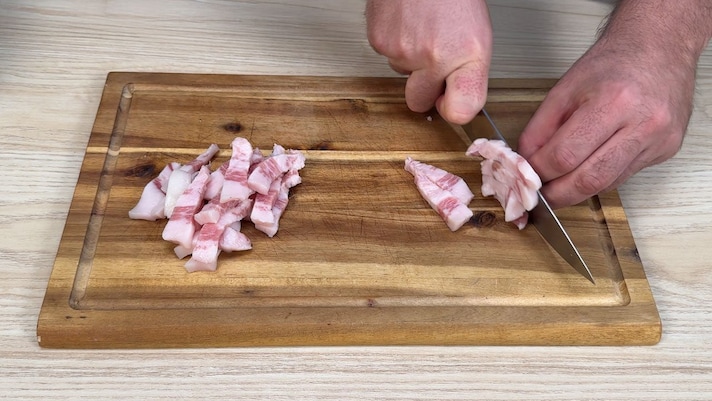
Cut the guanciale into strips.
Cut the guanciale into strips.
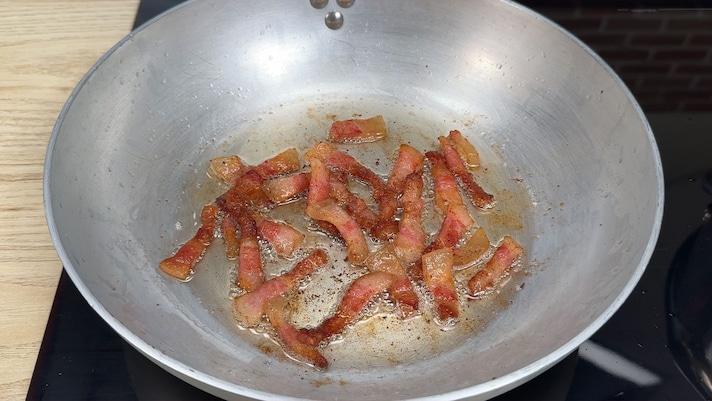
In a large skillet over medium-low heat, cook the guanciale until crispy and golden, about 5–8 minutes. Transfer to a plate and set aside, leaving the fat in the pan.
In a large skillet over medium-low heat, cook the guanciale until crispy and golden, about 5–8 minutes. Transfer to a plate and set aside, leaving the fat in the pan.
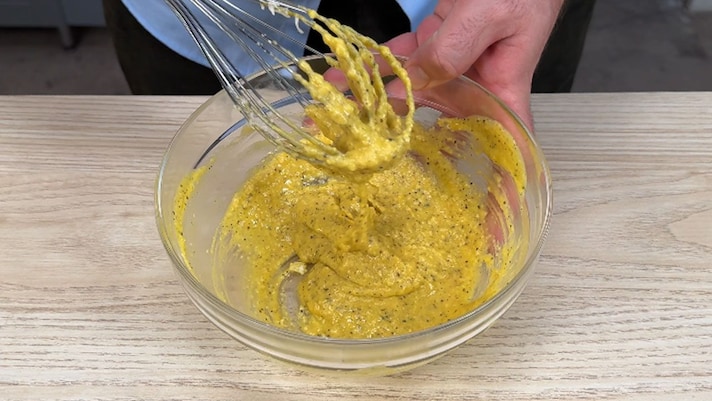
In a mixing bowl, combine the egg yolks, whole egg, Pecorino Romano, Parmigiano Reggiano, and freshly cracked black pepper. Whisk until smooth.
In a mixing bowl, combine the egg yolks, whole egg, Pecorino Romano, Parmigiano Reggiano, and freshly cracked black pepper. Whisk until smooth.
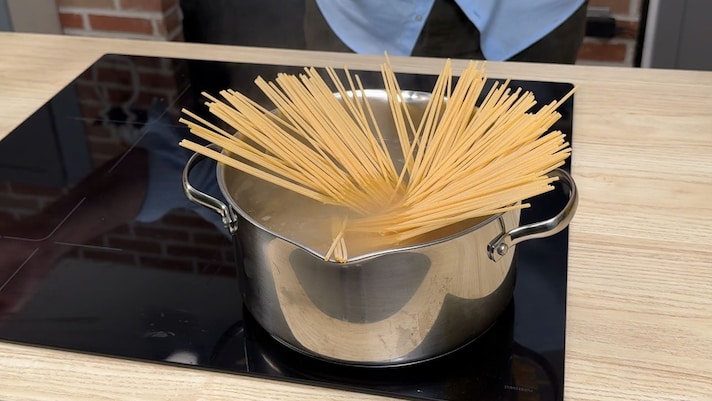
Bring a large pot of salted water to a boil. Cook the spaghetti until al dente, according to package instructions.
Bring a large pot of salted water to a boil. Cook the spaghetti until al dente, according to package instructions.
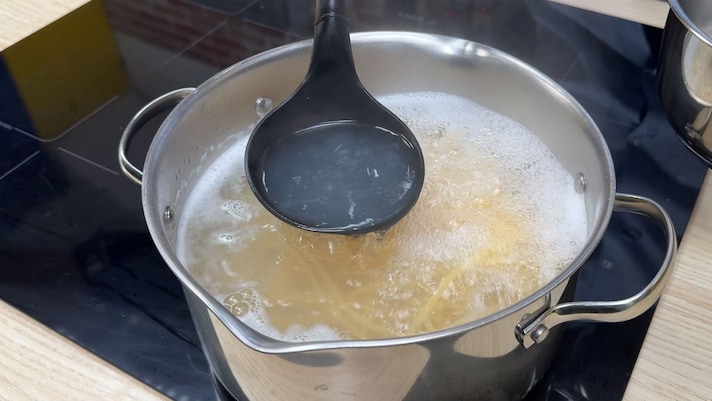
Reserve ½ cup of pasta water before draining.
Reserve ½ cup of pasta water before draining.
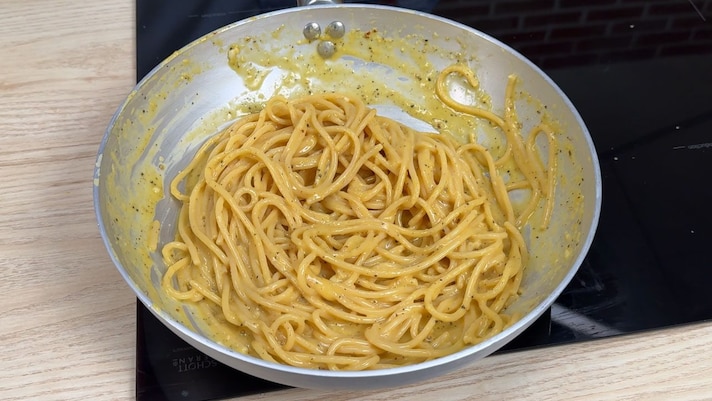
Add the hot, drained pasta to the pan with guanciale fat (heat off). Toss to coat. Quickly pour the egg and cheese mixture over the pasta while stirring constantly to create a creamy, glossy sauce. Add a few tablespoons of reserved pasta water to thin the sauce as needed and make it silky smooth. If the sauce feels too runny, return the pan to very low heat and stir constantly for 30–60 seconds. Be careful not to scramble the eggs.
Add the hot, drained pasta to the pan with guanciale fat (heat off). Toss to coat. Quickly pour the egg and cheese mixture over the pasta while stirring constantly to create a creamy, glossy sauce. Add a few tablespoons of reserved pasta water to thin the sauce as needed and make it silky smooth. If the sauce feels too runny, return the pan to very low heat and stir constantly for 30–60 seconds. Be careful not to scramble the eggs.

Plate immediately, top with extra Pecorino and cracked pepper, and enjoy!
Plate immediately, top with extra Pecorino and cracked pepper, and enjoy!
;Resize,width=767;)
;Resize,width=712;)
;Resize,width=712;)

